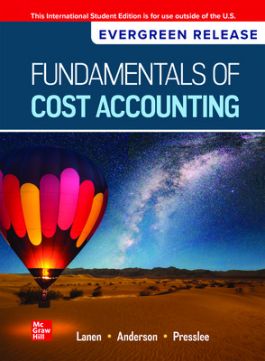Fundamentals of Cost Accounting: 2025 Release ISE
1265136947
·
9781265136949
Developing skills for the classroom and beyond: Fundamentals of Cost Accounting lets the student see the development of cost accounting tools and techniques as a natural response to decision making. Using a procedural approach, the material in the te…
Read More
INTRODUCTION AND OVERVIEW
1: Cost Accounting: Information for Decision Making
2: Cost Concepts and Behavior
COST ANALYSIS AND ESTIMATION
3: Fundamentals of Cost-Volume-Profit Analysis
4: Fundamentals of Cost Analysis for Decision Making
5: Cost Estimation
COST MANAGEMENT SYSTEMS
6: Fundamentals of Product and Service Costing
7: Job Costing
8: Process Costing
9: Activity-Based Costing
10: Fundamentals of Cost Management
11: Service Department and Joint Cost Allocation
MANAGEMENT CONTROL SYSTEMS
12: Fundamentals of Management Control Systems
13: Planning and Budgeting
14: Business Unit Performance Measurement
15: Transfer Pricing
16: Fundamentals of Variance Analysis
17: Additional Topics in Variance Analysis
18: Performance Measurement to Support Business Strategy
APPENDIX: Capital Investment Decisions: An Overview
1: Cost Accounting: Information for Decision Making
2: Cost Concepts and Behavior
COST ANALYSIS AND ESTIMATION
3: Fundamentals of Cost-Volume-Profit Analysis
4: Fundamentals of Cost Analysis for Decision Making
5: Cost Estimation
COST MANAGEMENT SYSTEMS
6: Fundamentals of Product and Service Costing
7: Job Costing
8: Process Costing
9: Activity-Based Costing
10: Fundamentals of Cost Management
11: Service Department and Joint Cost Allocation
MANAGEMENT CONTROL SYSTEMS
12: Fundamentals of Management Control Systems
13: Planning and Budgeting
14: Business Unit Performance Measurement
15: Transfer Pricing
16: Fundamentals of Variance Analysis
17: Additional Topics in Variance Analysis
18: Performance Measurement to Support Business Strategy
APPENDIX: Capital Investment Decisions: An Overview
Developing skills for the classroom and beyond: Fundamentals of Cost Accounting lets the student see the development of cost accounting tools and techniques as a natural response to decision making. Using a procedural approach, the material in the text is presented from the perspective of both the preparer of information and the user of the information. This allows both accounting majors and those students planning other careers to appreciate the issues from both sides.

